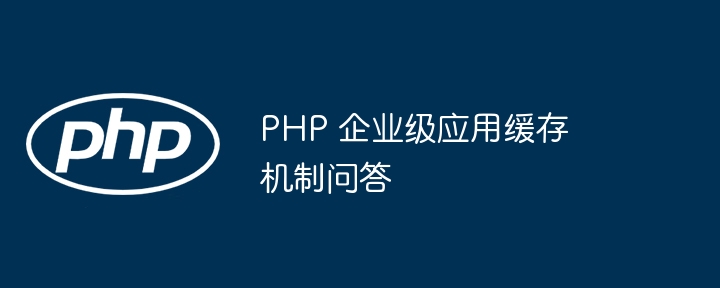Home >Backend Development >PHP Tutorial >Questions and Answers on PHP Enterprise Application Caching Mechanism
Questions and Answers on PHP Enterprise Application Caching Mechanism
- WBOYWBOYWBOYWBOYWBOYWBOYWBOYWBOYWBOYWBOYWBOYWBOYWBOriginal
- 2024-05-07 21:54:02900browse
Caching is critical in large enterprise-level PHP applications to improve performance and reduce server load. There are several caching mechanisms available in PHP: File Cache: Data is stored in disk files. In-memory cache: Data is stored in server memory, which is the fastest caching mechanism. NoSQL cache: Use a NoSQL database such as Redis or Memcached to store data. Choosing a caching mechanism depends on performance, capacity, and consistency. In the actual case of product catalog data caching on an e-commerce website, using Redis cache can improve the reading speed. Best practices include selecting appropriate data, setting expiration times, and using versioning.

Q&A on PHP enterprise-level application caching mechanism
In large-scale enterprise-level PHP applications, caching is very important, it can significantly to improve performance and reduce server load. This article will take an in-depth look at common caching mechanisms and provide practical examples to guide you in selecting and implementing the solution that best suits your application needs.
1. What is cache?
A cache is a middle layer that stores frequently accessed data to avoid repeated retrieval from a database or other source. This can significantly reduce latency and improve application response times.
2. What are the caching mechanisms in PHP?
Various caching mechanisms are provided in PHP:
- File caching: Store data in disk files.
- Memory Cache: Stores data in server memory, which is the fastest caching mechanism.
- NoSQL Caching: Use a NoSQL database such as Redis or Memcached to store data.
3. How to choose the appropriate caching mechanism?
When choosing a caching mechanism, consider the following factors:
- Performance: In-memory caching is faster than file caching, while NoSQL caching is somewhere in between between.
- Capacity: Memory cache is limited, while file cache and NoSQL cache have larger capacity.
- Consistency: In-memory caches may expire, while file caches and NoSQL caches are more durable.
4. Practical case:
Suppose you have an e-commerce website and frequently read product catalog data. You can cache this data using Redis as follows:
// 连接到 Redis 服务器
$redis = new Redis();
$redis->connect('127.0.0.1', 6379);
// 从 Redis 中获取数据,如果不存在则向数据库查询并缓存
if ( ! $products = $redis->get('products') ) {
$products = getDataFromDatabase();
$redis->set('products', $products, 3600); // 缓存 1 小时
}
// 打印商品目录
echo json_encode($products);5. Best Practices
When using the caching mechanism, follow the following best practices:
- Choose the right data: Cache data that is accessed frequently and changes slightly to get the most benefit.
- Set expiration time: Set an appropriate expiration time to balance performance and consistency.
- Use version control: When the data structure changes, update the version in the cache to ensure you get the correct version.
By implementing these caching mechanisms and best practices, you can significantly improve the performance and scalability of your enterprise-grade PHP applications.
The above is the detailed content of Questions and Answers on PHP Enterprise Application Caching Mechanism. For more information, please follow other related articles on the PHP Chinese website!

